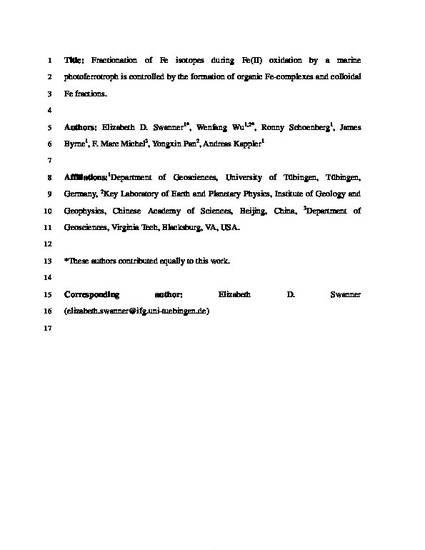
Article
Fractionation of Fe isotopes during Fe(II) oxidation by a marine photoferrotroph is controlled by the formation of organic Fe-complexes and colloidal Fe fractions
Geochimica et Cosmochimica Acta
(2015)
Abstract
Much interest exists in finding mineralogical, organic, morphological, or isotopic biosignatures for Fe(II)-oxidizing bacteria (FeOB) that are retained in Fe-rich sediments, which could indicate the activity of these organisms in Fe-rich seawater, more common in the Precambrian Era. To date, the effort to establish a clear Fe isotopic signature in Fe minerals produced by Fe(II)-oxidizing metabolisms has been thwarted by the large kinetic fractionation incurred as freshly oxidized aqueous Fe(III) rapidly precipitates as Fe(III) (oxyhydr)oxide minerals at near neutral pH. The Fe(III) (oxyhydr)oxide minerals resulting from abiotic Fe(II) oxidation are isotopically heavy compared to the Fe(II) precursor and are not clearly distinguishable from minerals formed by FeOB isotopically. However, in marine hydrothermal systems and Fe(II)-rich springs the minerals formed are often isotopically lighter than expected considering the fraction of Fe(II) that has been oxidized and experimentally-determined fractionation factors. We measured the Fe isotopic composition of aqueous Fe (Feaq) and the final Fe mineral (Feppt) produced in batch experiment using the marine Fe(II)-oxidizing phototroph Rhodovulum iodosum. The δ56Feaq data are best described by a kinetic fractionation model, while the evolution of δ56Feppt appears to be controlled by a separate fractionation process. We propose that soluble Fe(III), and Fe(II) and Fe(III) extracted from the Feppt may act as intermediates between Fe(II) oxidation and Fe(III) precipitation. Based on 57Fe Mössbauer spectroscopy, extended X-ray absorption fine structure (EXAFS) spectroscopy, and X-ray total scattering, we suggests these Fe phases, collectively Fe(II/III)interm, may consist of organic-ligand bound, sorbed, and/or colloidal Fe(II) and Fe(III) mineral phases that are isotopically lighter than the final Fe(III) mineral product. Similar intermediate phases, formed in response to organic carbon produced by FeOB and inorganic ligands (e.g., SiO44− or PO43−), may form in many natural Fe(II)-oxidizing environments. We propose that the formation of these intermediates is likely to occur in organic-rich systems, and thus may have controlled the ultimate isotopic composition of Fe minerals in systems where Fe(II) was being oxidized by or in the presence of microbes in Earth’s past.
Disciplines
Publication Date
September 15, 2015
DOI
10.1016/j.gca.2015.05.024
Publisher Statement
This is a manuscript of an article published as Swanner, Elizabeth D., Wenfang Wu, Ronny Schoenberg, James Byrne, F. Marc Michel, Yongxin Pan, and Andreas Kappler. "Fractionation of Fe isotopes during Fe (II) oxidation by a marine photoferrotroph is controlled by the formation of organic Fe-complexes and colloidal Fe fractions." Geochimica et Cosmochimica Acta 165 (2015): 44-61. Copyright 2015 Elsevier Ltd.
Citation Information
Elizabeth D. Swanner, Wenfang Wu, Ronny Schoenberg, James Byrne, et al.. "Fractionation of Fe isotopes during Fe(II) oxidation by a marine photoferrotroph is controlled by the formation of organic Fe-complexes and colloidal Fe fractions" Geochimica et Cosmochimica Acta Vol. 165 (2015) p. 44 - 61 Available at: http://works.bepress.com/elizabeth_swanner/4/
